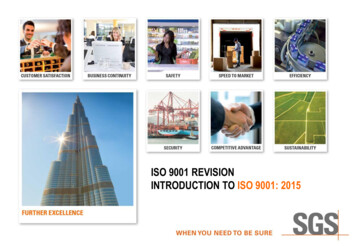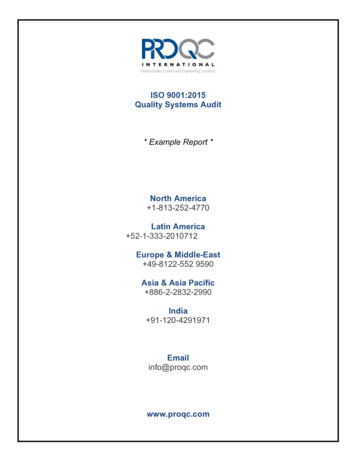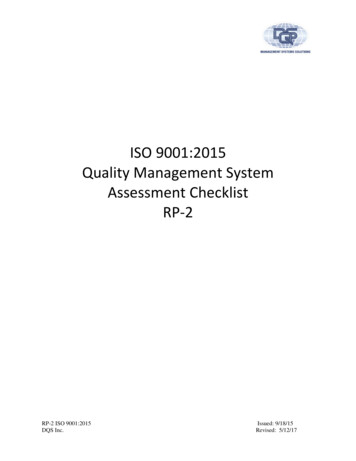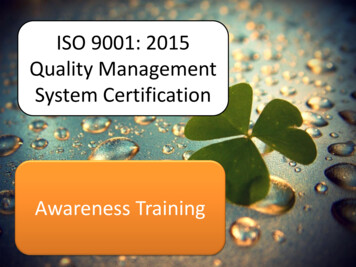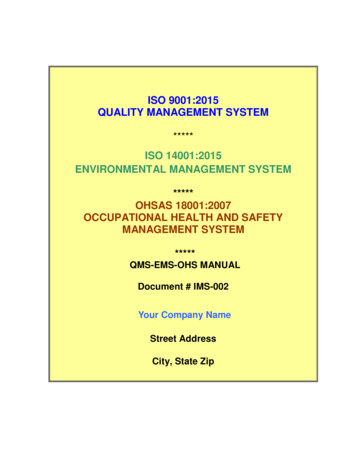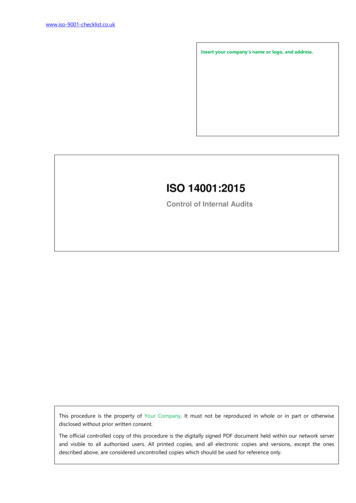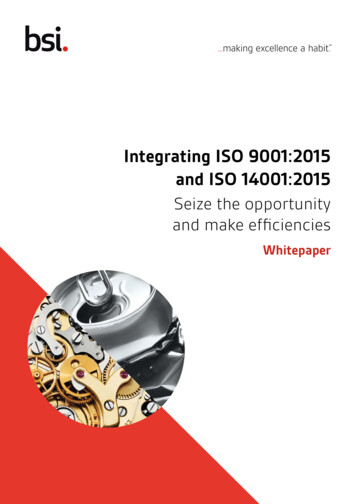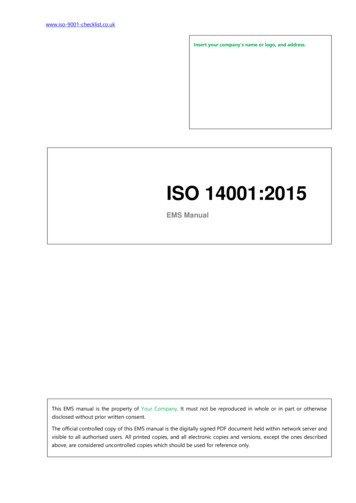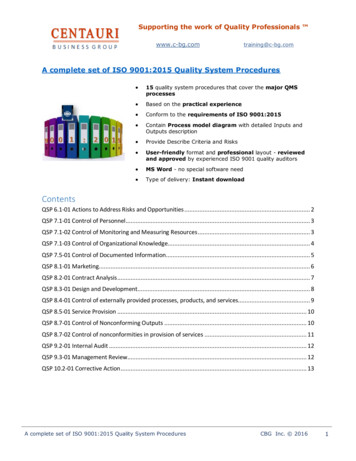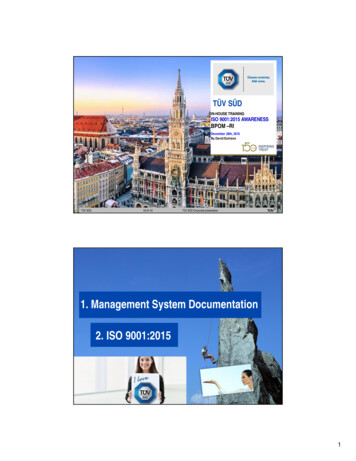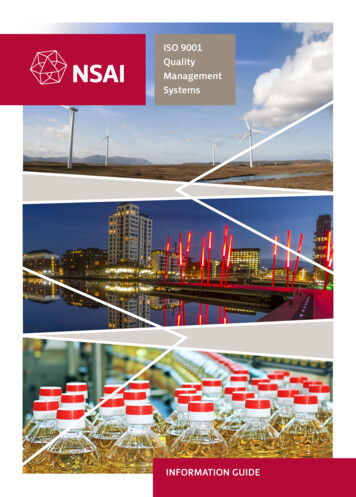
Transcription
ISO 9001QualityManagementSystemsINFORMATION GUIDE
ISO 9001 BackgroundISO 9001:2015 is the world’s foremost quality management standard, used by hundreds of thousands oforganisations in over 170 countries around the globe.It sets out the essential requirements for a practical and effective Quality Management System (QMS)which is, in essence, a system for minimizing risk and maximizing opportunity. ISO 9001 is suitablefor any organisation regardless of its size and industry. While it can be used to focus on improvingperformance in a particular department or site ISO 9001 is generally most effective when implementedthroughout an organisation at every level.ISO 9001:2015 is an update of ISO 9001:2008 and is part of a series of quality management systemstandards, sometimes referred to as ISO 9000. These currently comprise of the following standards andguidelines: ISO 9000:2015 – Fundamentals and Vocabulary, this standard describes the fundamental conceptsand principles of quality management ISO 9001:2015 – Requirements, which specifies the criteria for certification ISO/TS 9002:2016 – Guidelines for the application of ISO 9001:2015 ISO 9001:2015 for Small Enterprises - What to do? - This handbook was written by a group of expertsfrom ISO/TC 176/SC 2, and features useful information on everything from how to get started rightthrough to guidance for those who choose to seek certification.Benefits for your organisation include: Increase in your organisation’s performance and productivity –certification improves efficiency through reduction of waste andsystematic measurement of performance. Having a robustsystem in place gives more time to invest in performance &productivity Enhanced customer satisfaction – Customers know what toexpect from a quality certified company. ISO 9001 systematicallytracks errors and prevents them thus reducing the number ofcustomer complaints Global recognition – ISO 9001 is a globally recognised qualitystandard that can open new market opportunities orhelp to maintain current market share. Certification also attractsinvestment Employee engagement – An ISO 9001 Quality managementsystem encourages communication and increases morale amongthe employees Competitive advantage – certification provides an advantage over competitors or the opportunityto compete on the same basis as larger organisations (e.g. ability to tender or submit pricequotations) Focus on objectives and customer expectations – greater emphasis on meeting customerrequirements and implied needs through continuous incremental improvement Ease of integration with other management systems2MD-02-12 Rev 3
Key Principles Behind ISO 9001The seven principles below are fundamental attributes of any quality management system. They havebeen taken from ISO 9000:2015 Quality Management Systems – Fundamentals and Vocabulary and haveserved as a basis for the new ISO 9001:2015 standard.The seven key quality principles set out the rationale behind how a good organisation is managed. Theyguide the organisation on a path of continual improvement to ensure sustainability, particularly inchanging times. The seven key principles themselves are not directly auditable, but their applicationwithin the standard is.1.Customer FocusIt is essential for your organisation to understand current and future customer needs. You should strive tomeet customer requirements and exceed customer expectations. This could be done by communicationthroughout the organisation, measuring customer satisfaction and systematically managing customerrelationships. Ensuring a balanced approach and acting on findings is vital.2.LeadershipLeaders should provide a clear vision of your organisation’s future and set challenging goals and targets.It is only through unity of purpose and direction of employees an organisation’s objectives are achieved.Leaders should maintain an internal environment where people can get fully involved by establishing trustand eliminating fear.3.Engagement of PeoplePeople should be a core competency of every company. Involving people and their abilities at all levels canonly benefit your organisation. Motivating people, holding them accountable for their own performanceand involving them in decision making inspires innovation and creativity.4.Process ApproachManaging activities and resources as a process gives clear indications of what all the inputs and outputsare and thus gives a clearer idea of how to achieve your desired outcomes.5.ImprovementContinuously improving your processes and systems and thus improving the organisational overallperformance should be a permanent organisational objective.6.Evidence-based Decision MakingDecisions should be based on the analysis of reliable and accurate data and information. Analysiscombined with experience and intuition is a powerful decision making tool.7.Relationship ManagementThe enhancement of the ability to create value depends on the relationships with suppliers. There shouldbe a balance between short term gains and long term considerations which then results in increasedflexibility and optimisation of costs and resources.MD-02-12 Rev 33
Fundamental Elements of ISO 9001The Plan – Do – Check – Act (PDCA) cycle is the foundation of all ISO management system standards. ThePDCA cycle enables an organisation to ensure that its processes are adequately resourced and managed,and that opportunities for improvement are determined and acted on.Risk based thinking enables an organisation to determine the factors that could cause its processes andits quality management system to deviate from the planned results, to put in place preventive controls tominimise negative effects and to make maximum use of opportunities as they arise.It consists of the following:Plan – establish the objectives of thesystem and its processes, and the resourcesneeded to deliver results in accordancewith customers’ requirements and theorganisation’s policies, and identify andaddress risks and opportunitiesDo – implement what was plannedCheck – monitor and (where applicable)measure processes and the resultingproducts and services against policies,objectives, requirements and plannedactivities, and report the resultsAct – take actions to improve performance,as necessaryThis process then continues, thereby driving continual improvement at every level of the organisation.It is most likely that an organisation already has a quality management system but it is probably informaland not well documented. ISO 9001 provides a more systematic approach to achieving organisation’sobjectives. It should not result in excessive bureaucracy, paperwork or lack of flexibility nor should it bea financial burden. Quality management systems should be considered an investment as the return oninvestment will be in terms of the previously mentioned benefits and improvements.A documented quality manual is optional. However, an organisation must provide documentedinformation as required by the standard (ISO 9001:2015)4MD-02-12 Rev 3
Understanding the DetailsPlan, Do, Check, Act (PDCA)Plan – Management responsibilityThe PDCA cycle starts with management as it is up to them to identify appropriate processes and relevantareas of focus.Process identification:Appropriate process identification is essential to a practical system and the key is to start with twoprocesses (Management and Operations) and then decide if sub-processes are necessary rather thanworking “bottom up”. Each process has to also have an “owner” that is responsible for the activities thatrelate to the success criteria of the process.Planning and review:The organisation is required to set out clear plans as tohow they will achieve the quality objectives. The purposeof this planning process is to insure you meet yourobjectives and targets including customer requirementsand prevent non-conformities occurring - for both productand services.You determine the risks and opportunities that confrontyour organisation in delivering its products or services andplan actions to address them.An organisation may utilise various types of documentedinformation to capture their planned actions such as: Quality Policy, mission, vision, goals and purpose statements Strategy, business plans and operations plan Operating procedures, work instructions, flow charts including KPI’s Software programmes and schedules, drawings, registers and checklists Internal audits, non-conformance analysis, customer feedback loopsFundamental direction:Owners or managers of your organisation should establish the fundamental direction of the QMS usingthe Quality Policy. There are several aspects that have to be thought through while designing theQuality Policy: Leadership - Top management shall demonstrate leadership and commitment with respect to theQMS Context - the organisation shall determine external and internal issues that are relevant to itspurpose and its strategic direction and that affect its ability to achieve the intended result(s) of itsQMS Strategy – should follow from the Quality Policy and the business environment Risks and Opportunities - When planning for the QMS, the organisation shall determine the risksand opportunities that need to be addressed to give assurance that the QMS can achieve it’sintended result(s), enhance its desirable effects, prevent or reduce undesired effects and achieveimprovement Customer focus – system processes have to be designed to ensure customer satisfaction Support – The organisation shall determine and provide the resources needed for the establishment,implementation, maintenance and continual improvement of the QMSMD-02-12 Rev 35
Understanding the DetailsPlan, Do, Check, Act (PDCA)Do – implementation and useHaving established the system it has to be used to ascertain it works in the way it was intended. It will benecessary to use documented information such as forms, checklists and work instructions in the way thesystem was planned.The direction from your management and the assigned resources should make this part of the processfairly easy to implement. It is important to plan and define the processes all along the supply chain, thismight include: Sales Purchasing Research and Development Manufacturing DeliveryDon’t worry if some of the steps don’t apply to you. ISO 9001 certification is designed for every type oforganisation, just work on the aspects that are relevant to you.Check – review of resultsAt appropriate intervals, the results of QMS should be reviewed. The intervals will be short when thesystem is new but can be longer once the QMS becomes mature. The reporting of results against theprocess success criteria should be regular and be used by management to ensure that the business ison track. Records should be designed to facilitate prompt recording as well as the early detection ofproblems.Don’t worry if your organisation has some problems (or “challenges” as we call them), everyorganisation has them but a successful one will identify these at an early stage and deal with them inan effective manner.A key milestone in evaluating the QMS is the management review, a meeting which assesses whether theQMS has succeeded in meeting: Strategic objectives Process success criteria including Risks & Opportunities ISO 9001 requirementsReviewing perceived customer satisfaction is a key metric that has to be reviewed. It is recognised thatthe handling of complaints is not enough; customers may just move their business to a competitor.Probably the most important characteristic of a successful QMS is internal audits. Internal audits area key tool to enable an Organisation to review whether its system is effective and to drive continualimprovement.6MD-02-12 Rev 3
Understanding the DetailsPlan, Do, Check, Act (PDCA)Act – continual improvementYour organisation determines opportunities for improvement, as well as plans and actually implementsactions in order to achieve the intended results and to enhance customer satisfaction. Improvements canhelp it to keep meeting customer requirements and expectations by improving its products and services,correcting or preventing undesired effects, and improving the performance and effectiveness of yourQMS.There are differenct methods to conduct improvement, such as: taking actions to avoid the recurrence of nonconformities small-step ongoing improvement activities conducted withing existing processes, products or services projects which can lead to significant changes to existing processes, the implementation of newprocesses, products or services, or the introduction of disruptive new technologies or innovations.As a checklist, the following questions should be asked: Customer Focus – Have you found out whatthe customer’s current and future need andexpectations are at a strategic level? Quality Policy – Does it really suit yourorganisation and reflect your customer’sexpectations, your vision and mission – and therequirements of the standard? Objectives – Are all the objectives measurableand linked to both the processes and to thestrategies? Plan The System – Have all the responsibilitiesbeen identified and communicated? Doeseveryone know what they need to do tocontribute to the success of the business – andthe QMS? Review at Regular Intervals – Are the results ofthe QMS being reviewed and compared againstplanned results? Is action being taken toimprove areas where results are not quite asgood as planned? Review root cause of failures (or non-conformites) -Can you establish the real cause of what wentwrong? How do you put the necessary actions inplace to stop it recurring? Principles – Management should review the 7principles mentioned earlier and how well thesystem delivers against these. Risks & Opportunities - has your Organisationassessed risks and opportunities? These mayimpact the QMSMD-02-12 Rev 37
Tips1.Top management commitment is vital if the system is to be introduced s
from ISO/TC 176/SC 2, and features useful information on everything from how to get started right through to guidance for those who choose to seek certification. Benefits for your organisation include: Increase in your organisation’s performance and productivity – certification improves efficiency through reduction of waste and systematic measurement of performance. Having a robust .
